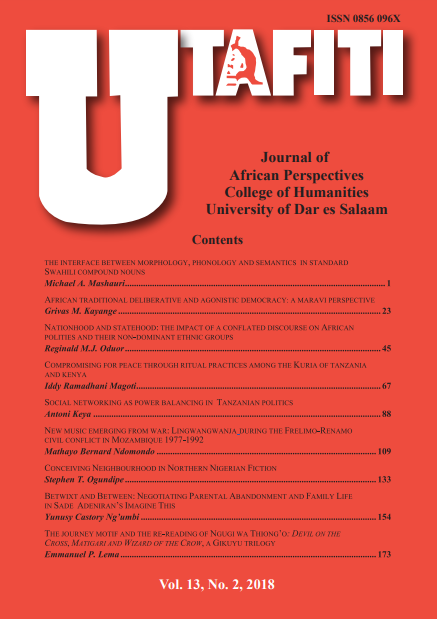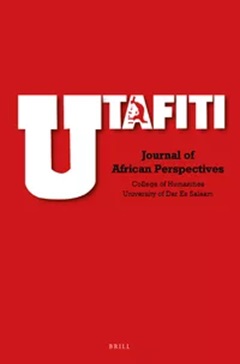Compromising for Peace Through Ritual Practices Among the Kuria of Tanzania And Kenya
Abstract
Kuria people, who straddle both sides of the Kenya €“Tanzania border, have experienced interminable intra- and inter-ethnic warfare emanating from cattle rustling. The Kuria people are stereotypically described as cantankerous and indisposed to compromise or forgiveness when they have been wronged. But on the contrary, archival and secondary information as well as oral interviews conducted in the region demonstrate that through participation in different ritual forms, the Kuria people themselves have been responsible for maintaining harmony and serenity with their neighbours. Kuria who abide by their cultural beliefs, social norms, and respect for traditional leadership, do forgive, regularly initiate reconciliations, and actively maintain peaceful relations through participation in various ritual forms. It is evident that rituals constitute an integral part of the customary process of conflict resolution and peace building among the Kuria. Especially those rituals related to the prevention of cattle rustling have gained recognition and formal support of the central states on both sides of the border, to the extent that the powers embodied in these traditional Kuria rituals have sometimes overridden the jurisdiction of modern courts established in the Kuria areas.
Key words: rituals, Kuria, peace-building, conflicts, conflict resolution
References
Abuso, Paul Asaka. 1980. A Traditional History of the Abakuria, C. A. D. 1400 €“ 1914. Nairobi: Kenya Literature Bureau.
Beidelman, T. O. 1963. The Blood Covenant and the Concept of Blood in Ukaguru. Africa: Journal of the International African Institute 33(4): 321-342.
Bock, Joseph G. 2002. Communal Conflict, NGOs, and the Power of Religious Symbols. In Development and Culture. Ed. Deborah Eade. London: Oxfam, pp. 78-91.
Chacha, Gabriel N. 1963. Historia ya Bakuria na Sheria Zao. Dar es Salaam: East African Literature Bureau.
Cohen, David William and E. S. Atieno Odhiambo. 1992. Burying SM: The Politics of Knowledge and the Sociology of Power in Africa. Portsmouth: Heinemann.
Eisenstadt, S.N. 1956. Ritualized personal relations: blood brotherhood, best friends, compadre, etc: Some comparative hypotheses and suggestions. Man 56: 90-95.
Evans-Pritchard, E.E. 1933. Zande Blood-Brotherhood. Africa: Journal of the International African Institute 6(4): 369-401.
Fleisher, Michael L. 1998. Cattle raiding and its correlates: The cultural ecological consequence of market-oriented cattle raiding among the Kuria of Tanzania. Human Ecology 26(4): 547-572.
Fleisher, Michael L. 1999. Cattle Raiding and Household Demography among the Kuria of Tanzania. Africa: Journal of the International African Institute 69(2): 238-255.
Fleisher, Michael L. 2000a. Kuria Cattle Raiders: Violence and Vigilantism on the Tanzania/Kenya Frontier. Ann Arbor: University of Michigan Press.
Fleisher, Michael L. 2000b. Kuria Cattle Raiding: Capitalist Transformation, Commoditization, and Crime Formation among an East African AgroPastoral People. Comparative Studies in Society and History 42(4): 745-769.
Fleisher, Michael L. 2002. War is Good for Thieving! The Symbiosis of Crime and Warfare among the Kuria of Tanzania. Africa: Journal of the International African Institute 72(1): 131-149.
Fred-Mensah, Ben K. 2000. Bases of Traditional Conflict Management among the Buems of the Ghana- Togo Border. In Traditional Cures of Modern Conflicts: Africa Conflict Medicine. (Ed.) William I. Zertman. London: Lynne Rienner Publishers, pp. 31-47.
Geertz, Clifford. 1973. The Interpretation of Cultures. New York: Basic Books.
Heald, Suzette. 2005. State, Law and Vigilantism in Northern Tanzania. African Affairs 105(419): 265-283.
Herlehy, Thomas J. 1984. Ties that bind: palm wine and blood-brotherhood at the Kenya Coast during the 19th Century. The International Journal of African Historical Studies 17(2): 285-308.
Hutchinson, Sharon Elaine. 2009. Peace and Puzzlement: Grass-roots peace initiatives between the Nuer and Dinka of Southern Sudan. In Changing Identifications and Alliances in North- East Africa. (Eds.) Gunther Schlee and Elizabeth E. Watson. New York: Berghahn Books, pp. 49-71.
James, Wendy. 2000. Kuria and the Passage of Life. Journal of Religion in Africa 30(1): 121-126.
Kenyatta, Jomo. 1961. Facing Mountain Kenya. London: Mercury Books.
Kingdon, D. 1957. Hadithi ya Bakuria wa Tanganyika. London: Macmillan.
King-Irani, Laurie E. 2000. Rituals of Reconciliation and Processes of Empowerment in Lebanon. In Traditional Cures for Modern
Conflicts: Africa Conflict Medicine. (Ed.) William I. Zertman.
London: Lynne Rienner Publishers.
Kjerland, Kirsten Alsaker. 1995. Cattle breed, shillings don ' t: The belated incorporation of the Abakuria into Modern Kenya. PhD dissertation, University of Bergen.
Magoti, Iddy Ramadhani. 2017. Ethnic Identity and the State: The Dynamics of Ethnic Relations in the Mara River Basin, 1900-2010. PhD dissertation, University of Dar es Salaam.
Mwakitalu, Tedness. 2013. Traditional Approaches to Conflict Management and Resolution in Tanzania: A Case of Traditional Council of Elders in Kyela District. MA thesis, University of Dar es Salaam.
Musaroche, L.P.R. (n.d.) Utani Relationships: The Kuria. Presented at the University of Dar Es Salaam, Tanzania.
Mutisi, Martha. 2009. Gacaca Courts in Rwanda: An Endogenous Approach to Post-Conflict Justice and Reconciliation. Africa Peace and Conflict Journal 2(1): 17-26.
Mutisi, Martha. 2011. The Abunzi Mediation in Rwanda: Opportunities for Engaging with Traditional Institutions of Conflict Resolution. ACCORD ' S Policy and Practice Brief, No. 012.
Nyaimaga, Enock. 2009. The Role of Grassroots Leadership in Conflict Resolution: A case of Three Selected Villages in Tarime District. Postgraduate diploma dissertation. Dodoma: Institute of Rural Development Planning.
Ramadhani, Iddy. 2007. Ethnic Conflicts in Tarime District from Late Precolonial Period to the Present. MA thesis, University of Dar Es Salaam
Ruel, Malcolm. 1958a. Kuria Generation Sets. Presented at East African Institute of Social Research, Kampala, Uganda.
Ruel, Malcolm. 1958b. Piercing. Presented at East African Institute of Social Research, Kampala, Uganda.
Ruel, Malcolm. 1965. Religion and Society among the Kuria of East Africa. Africa: Journal of the International African Institute 35(3): 295-306.
Ruel, Malcolm. 1991. Kuria Seers. Africa: Journal of International African Institute 61(3): 343-353.
Ruel, Malcolm. 2000. The Kuria Homestead in Space and Time. Journal of Religion in Africa. 30(1): 62-85.
Schirch, Lisa. 2005. Ritual and Symbols in Peace building. Bloomfield: Kumarian Press.
Shetler, Jan Bender. 2003. Interpreting Rupture in Oral Memory: The Regional Context for Changes in Western Serengeti Age
Organization. Journal of African History 44: 385-412.
Wasonga, Joseph. 2009. Rediscovering ' Mato Oput ' : The Acholi Justice System and the Conflict in Northern Uganda. Africa Peace and Conflict Journal 2(1): 27-38.
White, Luise. 1994. Blood Brotherhood Revisited: Kinship, Relationship, and the Body in East and Central Africa. Africa: Journal of the International African Institute 64(3): 359-372.
Zertman, I. William (Ed.) (2000). Traditional Cures for Modern Conflicts: Africa Conflict Medicine. London: Lynne Rienner.



